Understanding the Spiders on Drugs Study: The Science Behind Web Weaving Alterations
Have you ever imagined what happens when spiders encounter drugs like marijuana or caffeine? The Spiders on Drugs Study reveals surprising insights into the effects of substances on spider behavior and web construction, blending science with a touch of humor. Let’s dive into this fascinating world where spiders get a little too high!
The Fascination Behind the Experiment: A Unique Research Journey
The intriguing concept of studying spiders under the influence began in 1948 when Hans Peters, a researcher at the University of Tübingen in Germany, embarked on a pioneering journey. Peters was fascinated by how various substances might alter the behavior of spiders, particularly their web-spinning abilities. Conducting his experiments during the wee hours of the morning, he sought to uncover the impact of drugs on these remarkable arachnids.
The Quest for Understanding: How Drugs Impact Spider Behavior
Peters’ research aimed to answer a critical question: How do drugs affect the delicate balance of behavior in spiders? By observing the intricate web patterns and behaviors, Peters laid the foundation for a series of studies that would captivate scientists for decades.

Delving Into the Spiders on Drugs Study: Expanding Research Horizons
Following Peters, Peter Witt continued this groundbreaking research, exploring how different substances impacted spider behavior. The study involved administering a variety of drugs, including caffeine, marijuana, LSD, and chloral hydrate. Witt’s findings revealed the drastic changes in web patterns and behaviors that these substances induced in spiders.
The Experimental Setup: A Step-by-Step Guide
The experiment followed a detailed and methodical approach, allowing researchers to gain insights into how drugs impact spider behavior and web construction. Here’s a breakdown of the key steps involved in this unusual and intriguing study:
Selection of Spiders: Researchers primarily used common house spiders (Araneus diadematus), a species known for its well-structured webs. House spiders were chosen due to their predictable and consistent web patterns, making any alterations under the influence of drugs easier to observe and analyze. Additionally, their availability and ease of care made them ideal candidates for controlled experiments.
Drug Administration: The spiders were carefully administered specific doses of various drugs, including caffeine, marijuana, LSD, and chloral hydrate. Each substance was chosen for its known effects on the central nervous system in humans and animals. The researchers applied the drugs either by injecting the substances into the spiders or by incorporating them into their food or water supply. The goal was to ensure the spiders were under the influence of the drug while weaving their webs, allowing scientists to observe how these chemicals affected their natural instincts and motor skills.
Observation and Analysis: Once the drugs were administered, the spiders were given time to spin their webs. The researchers closely monitored how the drugs impacted their ability to construct webs, noting the design, symmetry, size, and overall structure. By comparing webs spun under the influence of different substances to control webs (created without drugs), the researchers could draw direct correlations between each drug and specific changes in web-spinning behavior.
The Impact of Drugs on Spider Webs: A Closer Look
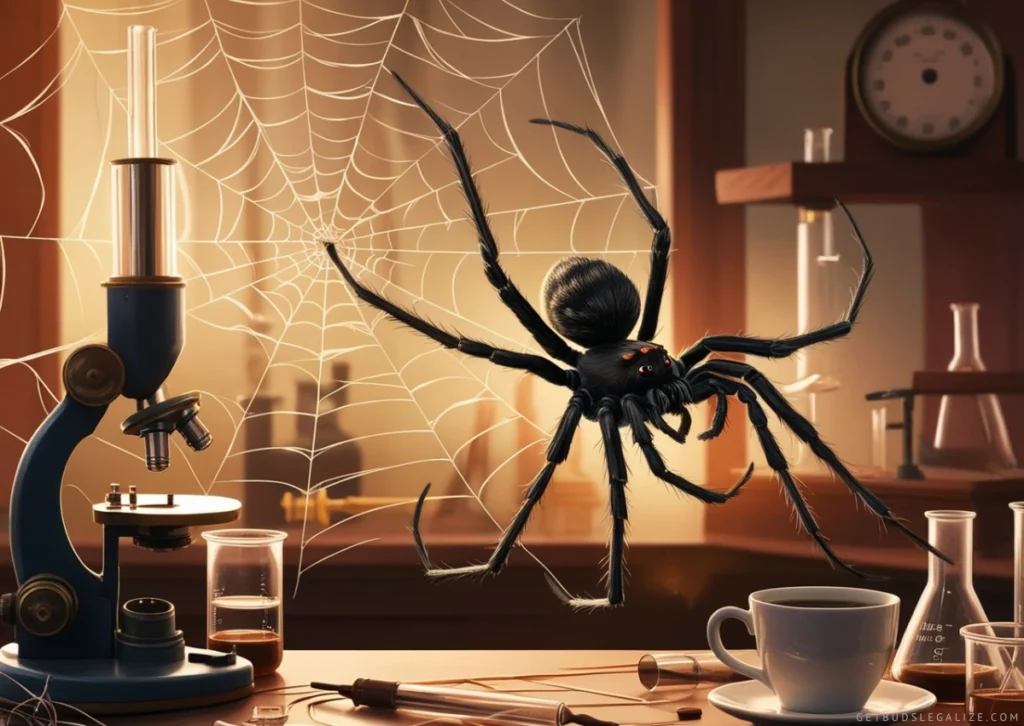
Caffeine: The Jittery Effect
When spiders were exposed to caffeine, the results were nothing short of chaotic. The spiders produced webs that were smaller, irregular, and lacked the elegance typically associated with their structures. The caffeine seemed to induce a state of restlessness, leading to erratic movements that affected their fine motor skills.
As a result, the webs displayed bizarre designs, often resembling tangled masses rather than functional structures. The increased heart rate and heightened anxiety triggered by caffeine disrupted the spiders’ natural rhythm, causing them to weave webs that were not only inefficient but also vulnerable to environmental stressors. This highlights how stimulants can significantly alter the behavior and capabilities of even the most skilled arachnids.
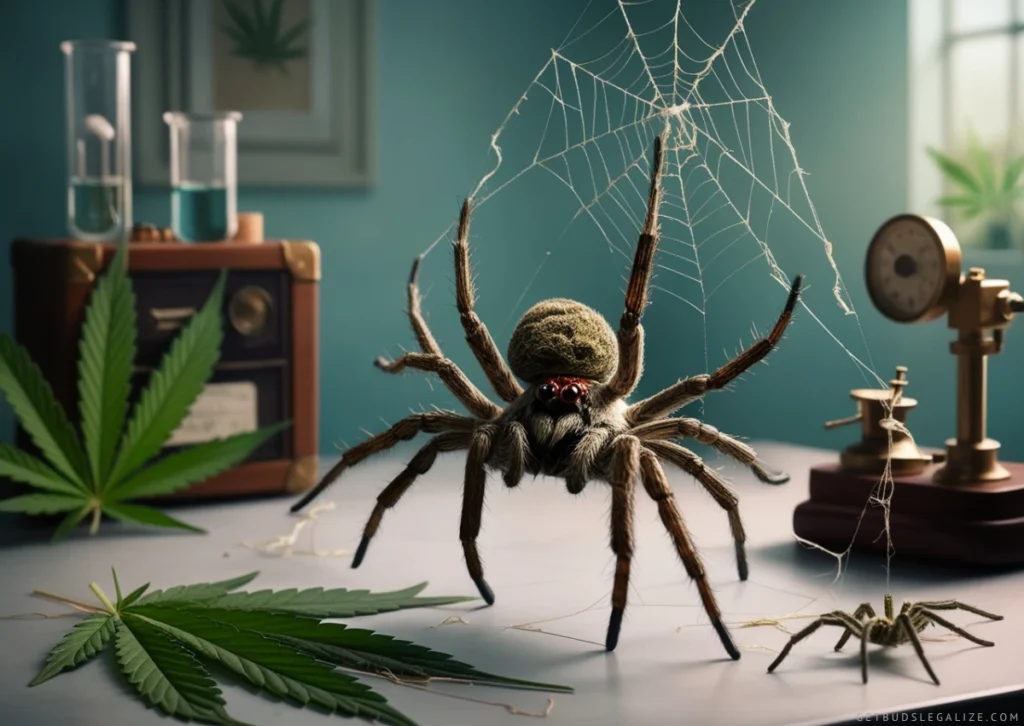
Marijuana: A Laid-Back Approach
Marijuana’s calming effects were evident in the behavior of the spiders. Those exposed to cannabis spun webs that were incomplete and often abandoned altogether, as if the drug induced a sense of apathy or lethargy.
This highlights how the relaxing properties of marijuana can disrupt motivation and productivity, even in the spider world. The webs they attempted to construct were often less intricate and lacked the precision seen in their sober counterparts. Instead of the intricate patterns that characterize spider webs, the designs appeared disjointed and haphazard, suggesting that the tranquilizing effects of marijuana led to a lack of urgency in their work.
The study serves as a reminder of how substances can profoundly influence not just human behavior but also the actions of simpler organisms.
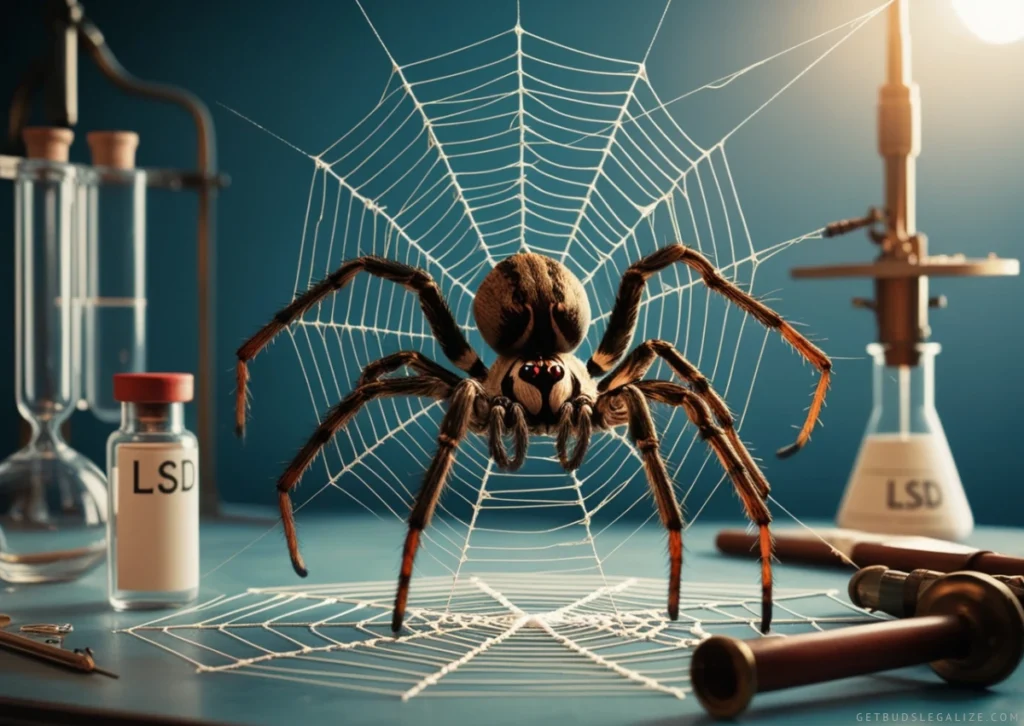
LSD: Enhancing Creativity?
In a surprising twist, low doses of LSD led to a unique outcome: spiders produced more organized and symmetrical webs. Unlike the disarray seen with caffeine and marijuana, LSD seemed to enhance the spiders’ ability to focus, allowing them to tap into a different level of creativity.
The webs spun under the influence of LSD exhibited intricate patterns and remarkable symmetry, resembling their natural designs more closely than webs produced under the influence of other substances. This suggests that LSD may enhance cognitive functions related to creativity and focus, allowing spiders to produce webs that are not only aesthetically pleasing but also potentially more effective for capturing prey.
The findings raise intriguing questions about the potential for drugs to unlock latent creative abilities across different species.
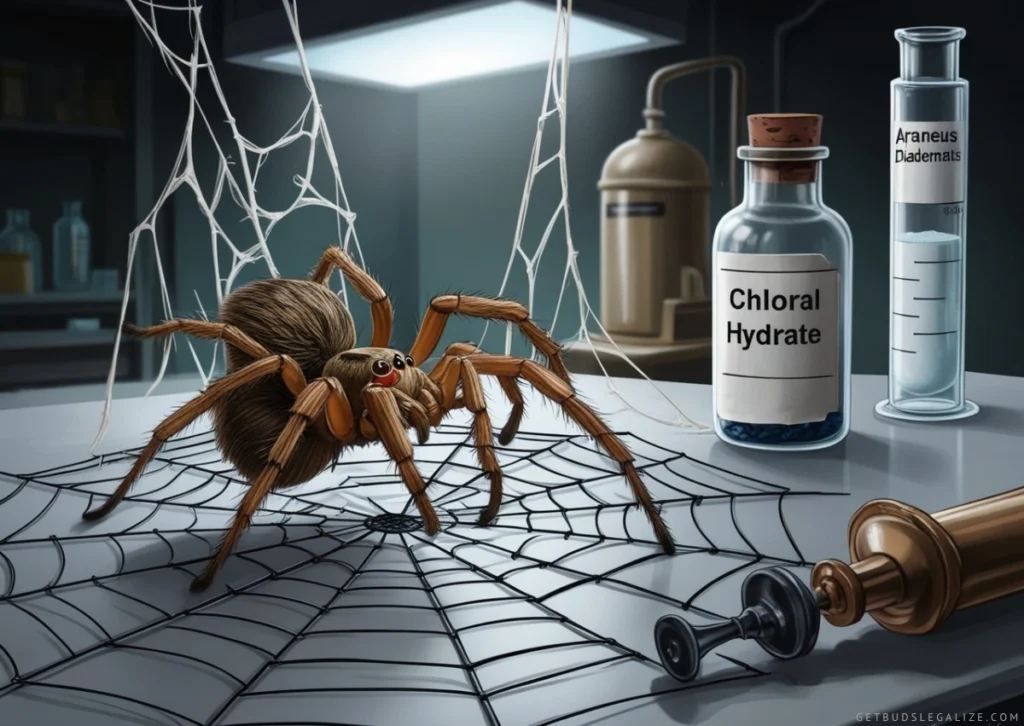
Chloral Hydrate: The Sedative Influence
Spiders subjected to chloral hydrate displayed pronounced lethargy in their web construction. The webs were often half-finished or poorly constructed, demonstrating how sedatives can dampen energy and enthusiasm for completing intricate tasks.
Spiders exposed to chloral hydrate took longer to initiate web-building activities, and when they did attempt to weave, their movements were slow and uncoordinated. The resulting webs were flimsy and lacked the structural integrity necessary for effective prey capture.
This suggests that sedatives not only affect the spiders’ motivation but also impair their ability to execute complex behaviors, further emphasizing the impact of different substances on arachnid productivity and efficiency.
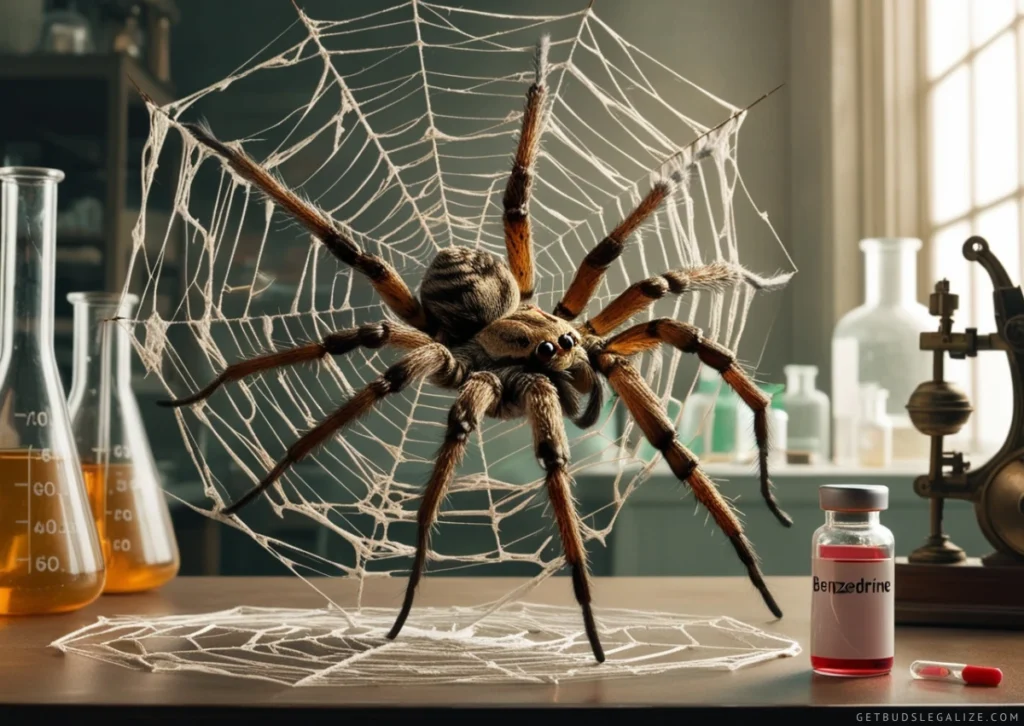
Benzedrine: The Stimulant Effect
When exposed to Benzedrine, a powerful stimulant, spiders exhibited heightened energy levels, leading to frantic web-building activity. Unlike the chaotic patterns observed with caffeine, the webs spun under Benzedrine were unusually dense and complex.
The spiders appeared to work at an accelerated pace, producing intricate designs but often sacrificing structural integrity. This suggests that while stimulants can boost energy and productivity, they may also lead to hasty decisions in web construction, impacting the overall functionality of their webs.
The rushed nature of their work resulted in webs that, while visually elaborate, lacked the careful craftsmanship that typically defines spider architecture. This raises interesting considerations about the balance between speed and quality in web construction and how various substances can disrupt this equilibrium.
NASA's Fascinating Revisit to the Study: Exploring Microgravity Effects

A New Frontier in Spider Research
In 1995, NASA decided to take inspiration from this study to explore the effects of substances on spiders in microgravity. Utilizing advanced computing technology, scientists aimed to analyze how weightlessness impacted spider behavior while under the influence of various drugs.
Groundbreaking Findings from NASA: Consistent Results Across Environments
The results echoed those of earlier studies. Spiders exposed to caffeine and marijuana spun incomplete and chaotic webs, demonstrating that the effects of drugs on spider behavior remained consistent, regardless of environmental conditions. This research provided valuable insights into the influence of toxins on living organisms in space.
Implications of the Research: A Shift in Toxicity Testing
The insights from the “Spiders on Drugs Study” could have profound implications for the field of toxicology. By observing how various substances affect spider web patterns, researchers can develop new methods to assess the toxicity of chemicals without resorting to animal testing on mammals. This not only saves time and resources but also promotes ethical research practices.
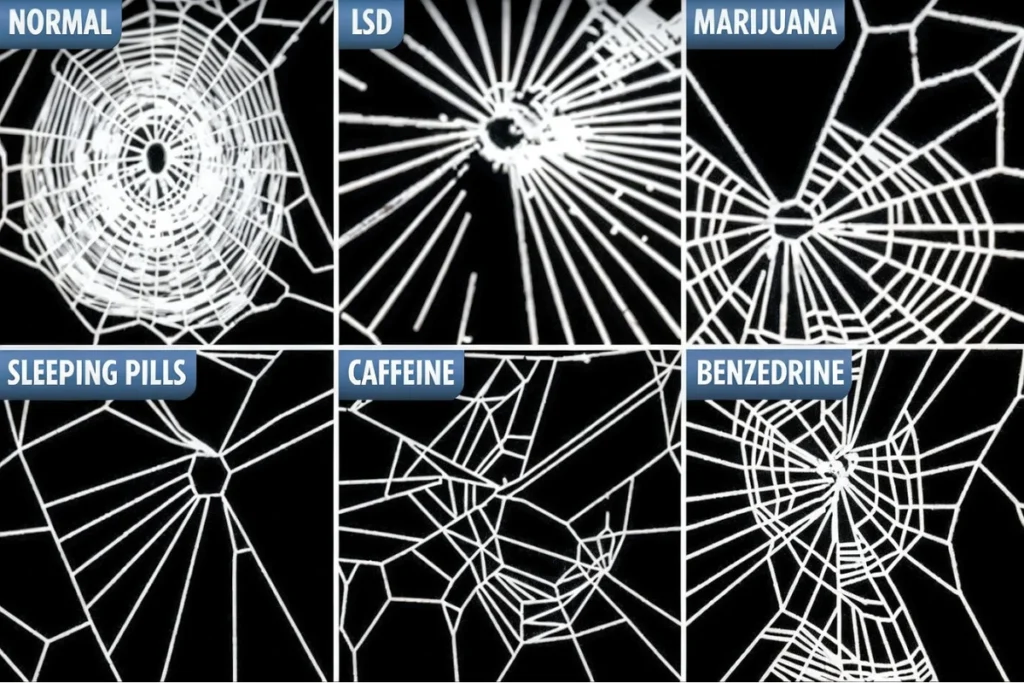
Ethical Considerations in Animal Research: Reducing Suffering
Using spiders for such experiments raises important ethical questions. By shifting the focus to simpler organisms, scientists can reduce the suffering of more complex animals while still obtaining significant scientific knowledge. This approach aligns with modern ethical standards in research.
Conclusion: Discovering Insights into Drug Effects Through Spider Behavior
The “Spiders on Drugs Study” combines scientific curiosity with a touch of humor, revealing the astonishing effects of various substances on spider behavior. The findings highlight the intricate relationship between drugs and behavioral changes, offering potential applications in toxicology and animal welfare.
As researchers continue to explore this fascinating topic, we deepen our understanding of these small creatures and pave the way for more humane scientific practices. Who knew that the tiny world of spiders could provide such profound insights into the impact of drugs on behavior?
SPIDERS ON DRUGS ORIGINAL VIDEO:
Frequently Asked Questions about Spiders on Drugs
Researchers aimed to understand how various substances impact the behavior and web construction of spiders on drugs, providing insights into neurological functions. By examining how these small creatures react to different drugs, scientists can gain a deeper understanding of the basic principles of neurology and behavior that may apply to larger animals, including humans.
A variety of substances were tested in the “spiders on drugs” study, including caffeine, marijuana, LSD, chloral hydrate, and amphetamines. Each of these substances was chosen for its known effects on the central nervous system, allowing researchers to observe a range of behavioral changes in spiders.
Caffeine caused spiders on drugs to weave smaller and more chaotic webs, reflecting the drug’s stimulating effects and its impact on fine motor skills. This chaotic web structure serves as a fascinating representation of how even simple organisms can exhibit complex responses to substances that alter their neurological states.
Marijuana resulted in incomplete webs among the spiders on drugs, indicating a lack of motivation to finish their work, showcasing the drug’s relaxing properties. This observation raises questions about how different substances can influence an organism’s drive and work ethic, even in the context of web construction.
Yes, low doses of LSD led to more symmetrical and organized webs, suggesting enhanced focus and creativity among the spiders on drugs. These findings not only provide insight into spider behavior but also open up discussions about how drugs can affect creativity and cognitive functions across species.
NASA sought to understand how substances affect spiders on drugs in microgravity, contributing to research on the effects of toxins on living organisms. The findings from NASA’s research help to advance our understanding of biological processes in space, shedding light on how different environments may alter drug effects on various organisms.
The findings from the “spiders on drugs” research may help develop new methods for assessing chemical toxicity, reducing the need for animal testing on mammals. This research could also inform guidelines for the safe use of drugs in both environmental and medical contexts, emphasizing the importance of understanding drug effects on all forms of life.
Yes, the idea that spiders on drugs might experience the “munchies” after marijuana exposure adds a lighthearted twist to the research findings. These humorous interpretations often help to engage a broader audience and spark interest in scientific research.
Yes, some spiders on drugs exposed to caffeine and marijuana left their webs incomplete or abandoned them altogether. This behavior suggests that the influence of these substances extends beyond just the act of web weaving, impacting the spiders’ overall behavior and decision-making processes.
The research demonstrates that different substances uniquely affect behavior and cognitive functions in simple organisms like spiders on drugs, offering insights into broader implications for more complex creatures, including humans. Understanding these effects can lead to more humane practices in scientific research and a better grasp of how various substances impact both animal and human behaviors.
For an entertaining and educational overview, check out the “Spiders on Drugs” documentary, which provides a visual representation of the research findings and their humorous implications. This video helps illustrate the profound effects of various substances on spider behavior while engaging viewers with its quirky presentation.
ILGM Fertilizer

- From seedling to harvest, give your plants everything they need.
- Enough for feeding at least 5 plants.
- Discounted Package Deal
- Works well in soil, hydroponics, and other growing mediums.
- The best way to treat your plants
ILGM Plant Protector

- Protect your cannabis from diseases and harmful pests.
- Contains three 20 ml bottles.
- Enough supplies to protect 20 plants.
- It can be used in soil, hydroponic, and all other growing mediums.





















